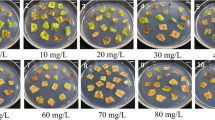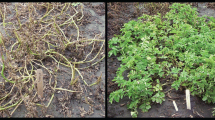Abstract
Solanum acaule Bitt., a wild potato species, is closely related to cultivated potato (Solanum. tuberosum L.). Incorporation of desirable traits from allotetraploid [2n=4x=48, 2 endosperm balance number (EBN)] S. acaule (acl) into autotetraploid (2n=4x=48, 4EBN) S. tuberosum (tbr) is difficult due to incongruity boundaries. In this study, three hybrid combinations, each with a specific genome constitution, were produced through protoplast fusion: (1) hexaploid 2x acl (+) 4x tbr, (2) tetraploid 2x acl (+) 2x tbr, and (3) hexaploid 4x acl (+) 2x tbr hybrids. In terms of glycoalkaloid aglycones, the hybrids produced demissidine, tomatidine and solanidine, similarly to the S. acaule parental species, but S. tuberosum synthesised only solanidine. Inoculations with Clavibacter michiganensis ssp. sepedonicus (Cms), which is the causal agent of bacterial ring rot in potato, yielded significantly lower total glycoalkaloid aglycone accumulation both in S. acaule plants and in interspecific hybrids in comparison with the corresponding mock-inoculated plants. However, in S. tuberosum the aglycone levels were either higher or unchanged as a result of infection by Cms. To incorporate the desirable traits of the interspecific somatic hybrids into 4EBN S. tuberosum, sexual backcrosses were carried out. The hexaploid 4x acl (+) 2x tbr hybrids with the hypothetical 4EBN showed the greatest capacity to undergo backcrosses with S. tuberosum.


Similar content being viewed by others
References
Beimen A, Bermpohl A, Meletzus D, Eichenlaub R, Barz W (1992) Accumulation of phenolic compounds in leaves of tomato plants after infection with Clavibacter michiganense subsp. michiganense strains differing in virulence. Z Naturforsch 47c:898–909
Bobeica VA, Kintia PK, Lupashku GA (1996) The influence of steroid glycosides and glycoalkaloids on the biochemical composition of tomato fruits. In: Fenwick GR, Hedley CL, Richards RL, Khokhar S (eds) Agri-food quality. An interdisciplinary approach. Royal Society of Chemistry, Cambridge, pp 100–103
Bouarab K, Melton R, Peart J, Baulcombe D, Osbourn A (2002) A saponin-detoxifying enzyme mediates suppression of plant defences. Nature 418:889–892
Brock TD, Madigon MT, Martinko JM, Parker J (1994) Biology of microorganisms. Prentice Hall, Englewood Cliffs
Brown CR, Adiwilaga K (1989) Introgression of Solanum acaule germ plasm from the endosperm balance number 2 gene pool into the cultivated endosperm balance number 4 potato gene pool via triplandroids. Genome 33:273–278
Burton WG (1989) The Potato, 3rd edn. Longman, New York
Carputo D, Garreffa P, Mazzei M, Monti L, Cardi T (1998) Fertility of somatic hybrids Solanum commersonii (2x, 1EBN) (+) S. tuberosum haploid (2x, 2EBN) in intra-and inter-EBN crosses. Genome 41:776–781
Choi D, Bostock RM, Avdiushko S, Hildebrand DF (1994) Lipid-derived signals that discriminate wound-and pathogen-responsive isoprenoid pathways in plants: methyl jasmonate and the fungal elicitor arachidonic acid induce different 3-hydroxy-3-methylglutaryl-coenzyme. A reductase genes and antimicrobial isoprenoids in Solanum tuberosum L. Proc Natl Acad Sci USA 91:2329–2333
Fewell AM, Roddick JG (1993) Interactive antifungal activity of the glycoalkaloids α-solanine and α-chaconine. Phytochemistry 33:323–328
Friedman M (2002) Tomato glycoalkaloids: role in the plant and in the diet. J Agric Food Chem 50:5751–5780
Friedman M, McDonald GM (1997) Potato glycoalkaloids: chemistry, analysis, safety, and plant physiology. Crit Rev Plant Sci 16:55–132
Friedman M, Fitch TE, Yokoyama WH (2000) Lowering of plasma LDL cholesterol in hamsters by the tomato glycoalkaloid tomatine. Food Chem Toxicol 38:549–553
Hawkes JG (1990) The potato: evolution, biodiversity and genetic resources. Belhaven, London
Iovene M, Frusciante L, Carputo D (2002) Shoot regeneration and chromosome doubling in accessions of 2x(1EBN) and 4x(2EBN) wild Solanum species. J Genet Breed 56:99–105
Iwanaga M, Freyre R, Watanabe K (1991) Breaking the crossability barriers between disomic tetraploid Solanum acaule and tetrasomic tetraploid S. tuberosum. Euphytica 52:183–191
Johnston SA, Nijs T den, Peloquin SJ, Hanneman RE Jr (1980) The significance of genic balance to endosperm development in interspecific crosses. Theor Appl Genet 57:5–7
Kozukue N, Misoo S, Yamada T, Kamijima O, Friedman M (1999) Inheritance of morphological characters and glycoalkaloids in potatoes of somatic hybrids between dihaploid Solanum acaule and tetraploid Solanum tuberosum. J Agric Food Chem 47:4478–4483
Laurila J, Laakso I, Valkonen JPT, Hiltunen R, Pehu E (1996) Formation of parental-type and novel glycoalkaloids in somatic hybrids between Solanum brevidens and S. tuberosum. Plant Sci 118:145–155
Laurila J, Laakso I, Väänänen T, Kuronen P, Huopalahti R, Pehu E (1999) Determination of solanidine-and tomatidine-type glycolkaloid aglycons by gas chromatography/mass spectrometry. J Agric Food Chem 47:2738–2742
Laurila J, Laakso I, Larkka J, Gavrilenko T, Rokka V-M, Pehu E (2001) The proportions of glycoalkaloid aglycones are dependent on the genome compositions of interspecific hybrids between two Solanum species (S. brevidens and S. tuberosum). Plant Sci 161:677–683
Laurila J, Metzler MC, Ishimaru CA, Rokka V-M (2003) Infection of plant material derived from Solanum acaule with Clavibacter michiganensis ssp. sepedonicus: temperature as a determining factor in immunity of S. acaule to bacterial ring rot. Plant Pathol 52:496–504
Matsubayashi M (1982) Species differentiation in Solanum, sect. Petota. Sci Rep Fac Agric Kobe Univ 15:23–33
Mohanakumaran N, Gilbert JC, Buddenhagen IW (1969) Relationship between tomatin and bacterial wilt resistance in tomato. Phytopathology 59:14
Paquin R (1966) Study on the role of the glycoalkaloids in the resistance of potato to bacterial ring rot. Am Potato J 43:349–354
Peloquin SJ, Boiteaux LS, Carputo D (1999) Meiotic mutants in potato: valuable variants. Genetics 153:1493–1499
Rokka V-M, Ishimaru CA, Lapitan NLV, Pehu E (1998a) Production of androgenic dihaploid lines of the disomic tetraploid potato species Solanum acaule. Plant Cell Rep 18:89–93
Rokka V-M, Tauriainen A, Pietilä L, Pehu E (1998b) Interspecific somatic hybrids between wild potato Solanum acaule Bitt. and anther-derived dihaploid potato (Solanum tuberosum L.). Plant Cell Rep 18:82–88
Rokka V-M, Valkonen JPT, Tauriainen A, Pietilä L, Lebecka R, Zimnoch-Guzowska E, Pehu E (2000) Production and characterization of “second generation” somatic hybrids derived from protoplast fusion between interspecific somatohaploid and dihaploid Solanum tuberosum L. Am J Potato Res 77:149–159
Shih M, Kuć J, Williams EB (1973) Suppression of steroid glycoalkaloid accumulation as related to rishitin accumulation in potato tubers. Phytopathology 63:821–826
Tegos G, Stermitz FR, Lomovskaya O, Lewis K (2002) Multidrug pump inhibitors uncover remarkable activity of plant antimicrobials. Antimicrob Agents Chemother 46:3133–3141
Van Gelder WMJ (1991) Chemistry, toxicology, and occurrence of steroidal glycoalkaloids: potential contaminants of the potato (Solanum tuberosum L.). In: Rizk AFM (ed) Poisonous plant contamination of edible plants. CRC, Boca Raton, pp 117–155
Van Gelder WMJ, Vinke JH, Scheffer JJC (1988) Steroidal glycoalkaloids in tubers and leaves of Solanum species used in potato breeding. Euphytica Suppl:147–158
Yamada T, Hosaka K, Nakagawa K, Kaide N, Misoo S, Kamijima O (1998) Nuclear genome constitution and other characteristics of somatic hybrids between dihaploid Solanum acaule and tetraploid S. tuberosum. Euphytica 102:239–246
Zook MN, Kuć JA (1987) Differences in phytoalexin elicitation by Phytophthora infestans and Helminthosporium carbonum in potato. Phytopathology 77:1217–1220
Zook, MN, Kuć JA (1991) Induction of sesquiterpene cyclase and suppression of squalene synthetase activity in elicitor-treated or fungal-infected potato tuber tissue. Plant Pathol 39:377–390
Acknowledgements
The authors wish to acknowledge Ms. Tiina Marttila (protoplast fusion), Ms. Sisko Holm (PCR analyses), Ms. Marja-Leena Manninen (glycoalkaloid aglycone extraction) and Ms. Kirsti Mäkelä (anther culture) for excellent technical assistance during the process. This work was financially supported by the Finnish Ministry of Agriculture and Forestry, Jenny and Antti Wihuri Foundation, Finnish Cultural Foundation, and the Foundation of Kemira. The authors are also grateful to Docent Jonathan Robinson for critical review of the manuscript.
Author information
Authors and Affiliations
Corresponding author
Additional information
Communicated by D. Dudits
Rights and permissions
About this article
Cite this article
Rokka, VM., Laurila, J., Tauriainen, A. et al. Glycoalkaloid aglycone accumulations associated with infection by Clavibacter michiganensis ssp. sepedonicus in potato species Solanum acaule and Solanum tuberosum and their interspecific somatic hybrids. Plant Cell Rep 23, 683–691 (2005). https://doi.org/10.1007/s00299-004-0868-x
Received:
Revised:
Accepted:
Published:
Issue Date:
DOI: https://doi.org/10.1007/s00299-004-0868-x




